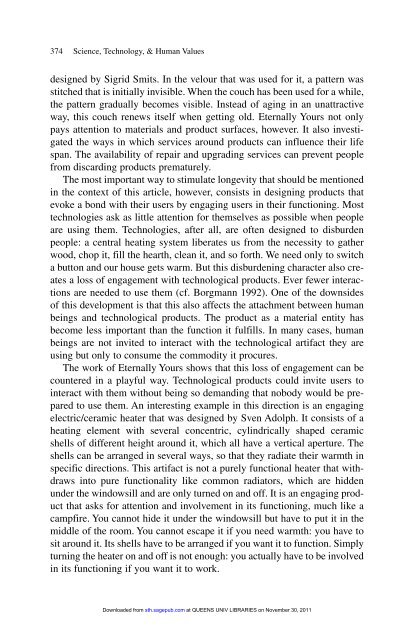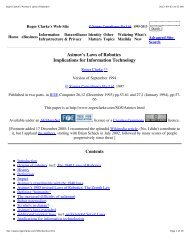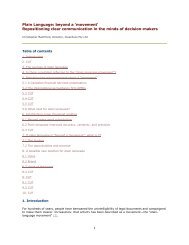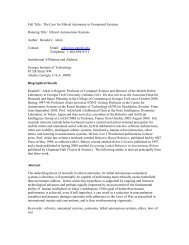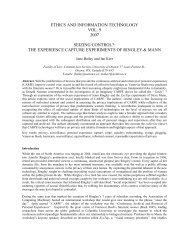Materializing Morality: Design Ethics and Technological Mediation.
Materializing Morality: Design Ethics and Technological Mediation.
Materializing Morality: Design Ethics and Technological Mediation.
Create successful ePaper yourself
Turn your PDF publications into a flip-book with our unique Google optimized e-Paper software.
374 Science, Technology, & Human Values<br />
designed by Sigrid Smits. In the velour that was used for it, a pattern was<br />
stitched that is initially invisible. When the couch has been used for a while,<br />
the pattern gradually becomes visible. Instead of aging in an unattractive<br />
way, this couch renews itself when getting old. Eternally Yours not only<br />
pays attention to materials <strong>and</strong> product surfaces, however. It also investigated<br />
the ways in which services around products can influence their life<br />
span. The availability of repair <strong>and</strong> upgrading services can prevent people<br />
from discarding products prematurely.<br />
The most important way to stimulate longevity that should be mentioned<br />
in the context of this article, however, consists in designing products that<br />
evoke a bond with their users by engaging users in their functioning. Most<br />
technologies ask as little attention for themselves as possible when people<br />
are using them. Technologies, after all, are often designed to disburden<br />
people: a central heating system liberates us from the necessity to gather<br />
wood, chop it, fill the hearth, clean it, <strong>and</strong> so forth. We need only to switch<br />
a button <strong>and</strong> our house gets warm. But this disburdening character also creates<br />
a loss of engagement with technological products. Ever fewer interactions<br />
are needed to use them (cf. Borgmann 1992). One of the downsides<br />
of this development is that this also affects the attachment between human<br />
beings <strong>and</strong> technological products. The product as a material entity has<br />
become less important than the function it fulfills. In many cases, human<br />
beings are not invited to interact with the technological artifact they are<br />
using but only to consume the commodity it procures.<br />
The work of Eternally Yours shows that this loss of engagement can be<br />
countered in a playful way. <strong>Technological</strong> products could invite users to<br />
interact with them without being so dem<strong>and</strong>ing that nobody would be prepared<br />
to use them. An interesting example in this direction is an engaging<br />
electric/ceramic heater that was designed by Sven Adolph. It consists of a<br />
heating element with several concentric, cylindrically shaped ceramic<br />
shells of different height around it, which all have a vertical aperture. The<br />
shells can be arranged in several ways, so that they radiate their warmth in<br />
specific directions. This artifact is not a purely functional heater that withdraws<br />
into pure functionality like common radiators, which are hidden<br />
under the windowsill <strong>and</strong> are only turned on <strong>and</strong> off. It is an engaging product<br />
that asks for attention <strong>and</strong> involvement in its functioning, much like a<br />
campfire. You cannot hide it under the windowsill but have to put it in the<br />
middle of the room. You cannot escape it if you need warmth: you have to<br />
sit around it. Its shells have to be arranged if you want it to function. Simply<br />
turning the heater on <strong>and</strong> off is not enough: you actually have to be involved<br />
in its functioning if you want it to work.<br />
Downloaded from sth.sagepub.com at QUEENS UNIV LIBRARIES on November 30, 2011


